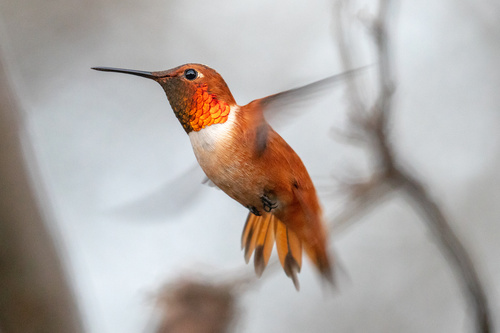
Rufous Hummingbird
The Rufous Hummingbird (*Selasphorus rufus*) is a small, highly migratory hummingbird known for its vibrant, iridescent plumage and feisty personality. It plays a crucial role as a pollinator in various ecosystems across western North America. This species is renowned for its incredibly long migration, one of the longest of any bird its size, traveling thousands of miles between its breeding and wintering grounds. While not holding specific cultural significance in the same way as some other birds, its arrival is often seen as a harbinger of spring in many communities.
7-9 cm
Length
10-11 cm
Wingspan
Near Threatened
Conservation Status
Distribution
Breeds from southeastern Alaska and western Canada south to northern California, extending east to Montana and Wyoming. Winters primarily in central Mexico, with some individuals along the Gulf Coast of the United States. Migratory routes generally follow the Pacific Flyway and the Rocky Mountains.
Lifespan
Average lifespan in the wild is not well documented, but the oldest known individual was over 8 years old based on banding records.
Rufous Hummingbird's Habitat
Habitat Types
Forest edges, Meadows, Mountain slopes, Suburban gardens, Chaparral
Climate Zones
Temperate, Subarctic, Subtropical
Adaptations
Rufous Hummingbirds are adapted to a wide range of altitudes and can tolerate cold temperatures, especially during migration. Their high metabolic rate requires frequent feeding, and they can enter a state of torpor (a short-term hibernation-like state) to conserve energy on cold nights.
Variations
No formally recognized subspecies, but some variations in plumage brightness and size have been observed across the range.
Appearance
Breeding Plumage
Males have bright rufous (reddish-brown) upperparts, flanks, and tail, with an iridescent orange-red gorget (throat patch). Females have green upperparts, rufous flanks, and a less brilliant gorget, often with just some iridescent spotting. Non-breeding plumage is similar, but males may show some green on the back.
Seasonal Feather Changes
Minimal seasonal variation beyond the intensity of the gorget in males, which may be brighter during breeding season.
Sex Based Plumage Differences
Significant dimorphism; males are much more brightly colored than females.
Notable Features
Iridescent orange-red gorget (in males), Rufous back and tail (in males), Straight, slender bill, Small size
Diet and Feeding
Primary Foods
Nectar from flowers, Small insects, Spiders, Tree sap
Foraging Behavior
Rufous Hummingbirds are agile fliers, hovering in front of flowers to feed on nectar. They also glean insects and spiders from leaves and branches, and occasionally hawk insects in mid-air. They are known to visit hummingbird feeders.
Specializations
Their long, slender bill and brush-tipped tongue are perfectly adapted for extracting nectar from tubular flowers. Their hovering flight allows them to access nectar sources that other birds cannot.
Seasonal Diet Variations
Diet shifts with seasonal availability. During breeding season, they consume more insects to provide protein for nestlings. In migration and winter, nectar and sap become more crucial for fueling their long journeys.
Behavior
Social Structure
Generally solitary, except during breeding season. Highly territorial, especially males, defending feeding territories aggressively.
Communication
High-pitched chittering calls, Buzzing sounds made with wings during displays, Aggressive chases and vocalizations
Migration
Undertakes one of the longest migratory journeys of any bird relative to its size. Migrates north along the Pacific coast in spring, taking advantage of early blooming flowers, and returns south along the Rocky Mountains in late summer, following the blooming season of mountain wildflowers.
Territorial or Group Behaviors
Extremely territorial, particularly males, defending nectar sources from other hummingbirds and even larger insects. Females also defend nesting territories.
Conservation
Threats
Habitat loss due to logging and development, Climate change (affecting flower bloom times and insect availability), Pesticide use in agriculture, Collisions with windows
Protection Programs
Habitat restoration projects, Monitoring of populations through bird banding, Public education campaigns to promote hummingbird-friendly gardening
Local National Laws
Protected under the Migratory Bird Treaty Act in the United States and Canada.
Population Trend
Decreasing
Population Estimates
Estimated at 19,000,000, although this number is considered a rough estimate and requires further research.
Interesting Facts
They can fly up to 60 mph during courtship dives.
This impressive speed is achieved during the male's display to attract females.
They can remember the location of individual flowers and feeders.
This spatial memory is crucial for efficient foraging.
They can enter a state of torpor to conserve energy.
This allows them to survive cold nights with reduced body temperature and metabolic rate.
Rufous Hummingbirds can beat their wings up to 52-62 times per second.
The rapid wingbeats are essential for hovering flight.
Faqs about Rufous Hummingbird
What should I do if I find an injured Rufous Hummingbird?
Contact a local wildlife rehabilitator. Do not attempt to care for it yourself, as hummingbirds have specialized needs. Consult a professional for medical or expert advice.
How can I attract Rufous Hummingbirds to my garden?
Plant native flowering plants, especially those with red or orange tubular flowers. Provide a clean hummingbird feeder with a sugar-water solution (1 part sugar to 4 parts water, no red dye).
Do Rufous Hummingbirds return to the same place every year?
They often do, showing strong site fidelity to both breeding and wintering grounds, and even to specific feeding locations.
Are Rufous Hummingbirds aggressive?
Yes, they are known for their aggressive and territorial behavior, especially males defending their feeding areas.
Copyright @ Nature Style Limited. All Rights Reserved.
 English
English